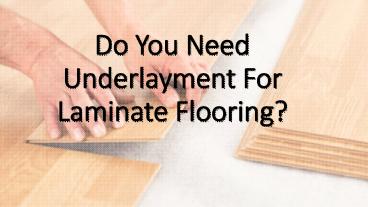Do you need underlayment for laminate flooring - PowerPoint PPT Presentation
Title:
Do you need underlayment for laminate flooring
Description:
Laminate flooring manufacturers will always recommend that you install underlayment before laying laminate flooring. Yet is it necessary? While underlayment is the safe, default choice, in some instances it is not necessary. Begin with the manufacturers' recommendations and reasoning before moving onto the opposite view. – PowerPoint PPT presentation
Number of Views:17
Title: Do you need underlayment for laminate flooring
1
Do You Need Underlayment For Laminate Flooring?
2
- Laminate flooring manufacturers will always
recommend that you install underlayment
before laying laminate flooring. Yet is it
necessary? While underlayment is the safe,
default choice, in some instances it is not
necessary. - Begin with the manufacturers' recommendations and
reasoning before moving onto the opposite view.
3
Reasons for Underlayment
- Sound Laminate flooring is so thin that it needs
underlayment's extra help to feel and act like
real wood. Consider sound transmission. You do
not need foam padding under solid hardwood for
many reasons, and one reason is because hardwood
alone limits the transmission of sound, both
within the room and to floors below. Laminate
flooring is thin--usually no more than 12mm--and
is made of a type of fiberboard. So underlayment
boosts laminate's sound absorbing qualities.
4
- Subfloor Imperfections This is the biggest issue
of all, what the flooring manufacturer might call
"subfloor imperfections." This means that your
subfloor is not perfectly flat and featureless,
which describes many subfloors. Solid or
engineered wood can bridge small gaps. Ceramic
and porcelain tile can bridge those gaps, plus
mortar works to fill them in. Underlayment helps
to prevent laminate damage.
5
- Moisture You will need moisture-proof
underlayment when there is a chance of moisture
migrating upward concrete slab, tile, cement
board, and even wood sub-floor or flooring over a
crawlspace or other non-climate-controlled
space. Underlayment and vapor barrier are not the
same thing. Common foam underlayment will inhibit
moisture. But there are types of underlayment
that require a separate 6 mil. polypropylene
vapor barrier.
6
- On Concrete When you are installing on top of
concrete, you may want the extra padding that
underlayment provides to make it softer to walk
on. Take note that underlayment is not
considered a vapor barrier. Manufacturers
typically recommend that you add a vapor barrier
in addition to the underlayment.
7
- Margin of Safety For The Company Product
liability providing a wide margin of safety and
appealing to a majority of installations these
are some reasons why flooring manufacturers make
this blanket recommendation. It is a case of
laminate makers wanting to ensure few problems
with the greatest number of installations.
8
When You Do Not Need It At All
- The only instance when you absolutely do not need
underlayment is when it already has underlayment.
Confused? - Your laminate might already have pre-attached unde
rlayment, rendering separate underlayment
unnecessary. - Rare only a few years ago, laminate with
pre-attached padding is now found in great
numbers. Over half of Lumber Liquidators'
laminates come with pre-attached padding over
75 of Pergo's laminates now have pre-attached
underlayment. - In this case, not only is separate underlayment
unnecessary, it is detrimental to the stability
of your flooring. When you have pre-attached
underlayment, manufacturers recommend that you
still install vapor barrier.
9
When You May Not Want It
- When Cost Is an Issue
- Underlayment can be surprisingly expensive. One
premium underlayment, Roberts AirGuard, costs
0.55 per square foot. This is not expensive in
relation to 7 per square foot laminate. But
when compared to cheap 0.49/sq. ft. clearance
laminate, the underlayment costs more than the
flooring itself. - When Your Base Surface is Moisture-Proof
- One popular mode of installation is to put
laminate on top of vinyl flooring. This
eliminates the need for removing the vinyl floor.
Vinyl flooring is not--or, should not--be
water-permeable. If it is water-permeable,
somebody installed the floor wrong. - Even hastily-installed peel 'n' stick vinyl floor
tiles can do a reasonably good job of holding
back the moisture.
10
- When You Do Not Want a Hollow Feeling Under Foot
- Foam laminate underlayment softens your footfall.
But it also makes the flooring feel hollow. - You notice it immediately when you walk from a
solid surface, like tile, to laminate with
underlayment. It is a singular feeling that
alerts you to the fact that you are on laminate
with foam padding. - Laminate flooring with denser felt
underlayment more closely approximates
the feeling of real wood flooring.
11
Laminate flooring
- Green Wood General Trading Co.
- Gold Crest Executive TowerJLT, Dubai, UAE
- Phone 971 4 450 88 75Fax 971 4 450 88 76
- Email info_at_greenwood.aeMail P.O.Box 123727
Dubai - UAE

